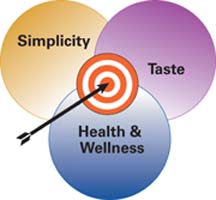
And here's great news for the dairy industry. Thanks to advancements in technology, researchers have shown that specific components of cows milk, as well as ingredients that are readily added to dairy products, can contribute to health and wellness, and assist consumers with feeling balanced and satisfied.
Antioxidants, anthocyanins, calcium, conjugated linoleic acid, fiber, lutein, phytosterols, probiotic cultures, proteins, vitamins, whey, the list goes on ... all of these have been shown to have specific positive effects on the body, and consumers are becoming aware of them through the media and medical community.
According to consumer research by Mintel International Group, an impressive 43% of respondents say they purchase functional foods and beverages occasionally and 56% would like to know more about their benefits. The term functional is quite arbitrary, but in general, it describes a food or beverage that provides health benefits or desirable physiological effects beyond basic nutrition.
"This data presents a golden opportunity for dairy marketers to formulate innovative products to meet consumers' needs and to effectively market the product's value," says Gail Barnes, business development manager, carton chilled, Tetra Pak.
It gets better. Recent research shows that dairy may also aid in weight loss. When calcium-rich dairy foods are part of a reduced-fat diet, three servings of milk, yogurt or cheese can help people lose weight and burn more fat. This is a fact that marketers can build on when formulating new dairy products.
"Consumers are reading and hearing all over the place about dairy's role in body composition and weight loss," says Barnes. "Now is the perfect time to launch a range of dairy products with weight management value propositions."

Indeed, health-conscious, yet time-deprived consumers are looking for quick-and-easy solutions to their needs. Drinks are quick and easy to consume, and more convenient than chewing food such as bars when in a hurry. The leading value-added beverage concepts focus on immunity, heart health, bone strength and energy.
Immunity can be linked to many factors. One such factor is gastrointestinal health, also called gut health, which is addressed by products containing probiotics and prebiotics. It is the most popular functional beverage category in Europe. Many marketers say that the time is right to introduce these products to U.S. consumers, as they are ready and willing to take an active role in maintaining their health.
At the end of the day, the key to launching successful new products is knowing your consumer and formulating a value proposition that gets across how the product provides a solution for today's complex consumer. And with that, dairy marketers are in a great position to drive industry growth for many years to come!
Sidebar: Functional Product Concepts
Sidebar: From Market Need to Finished Product
Some full service suppliers, such as Tetra Pak, assist customers with:- Identifying where the gaps are in a specific market-what the new/unmet consumer needs are.
- Developing product concepts and consumer value propositions to fill the gaps.
- Assisting in ingredient selection, formulating prototypes and evaluating product concepts at an in-house pilot plant.

Sidebar: Adding Value with Omega-3s
In Western Australia, PB Foods Ltd. recently rolled out Brownes Heart Plus, a specially formulated, low-fat milk containing added nutrients believed to be important for maintaining the performance of the heart and cardiovascular system. These nutrients are omega-3 fats and the vitamins B6, B12 and folate. Also, the antioxidant vitamins E and C are added so that the body can use the omega-3 nutrients efficiently.
"We wanted to be first on the market with an innovative product like Heart Plus," says Suzanne Perry, group product manager. "And we were. So far the product is very well received."

Sidebar: Targeting a Successful Product Launch
"Fundamentally your product needs to pass the taste test. If it does not taste good, you will never get that repeat buy from your consumer," says Jacquelyn Paul, director global nutritionals, Tetra Pak. Global nutritionals acts as an in-house international consulting group for Tetra Pak and its customers in the areas of health and wellness, food technology, product development and consumer marketing."And, If you don't feel well, you want to feel better," Paul says "If you are well, most consumers would like to maintain a high level of wellness.
"It all has to do with things like energy, appearance and performance-both physical and mental," Paul continues. "And finally, because there is so much nutritional information available to the consumer, we need to keep our communications and messages simple."
Indeed, most consumers have very hectic and filled days. "What we try to do is provide consumers with liquid solutions that simplify their choices and perhaps minimize some of the information overload they experience," Paul concludes. "When we develop products and their positioning, and we can hit a bull's eye in each one of these areas (health and wellness, simplicity and taste) we certainly have a stronger chance for a successful product launch."


